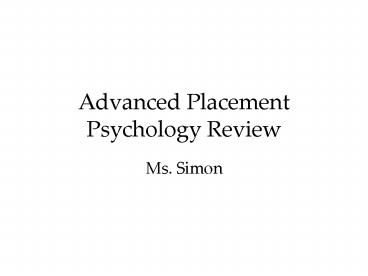Advanced Placement Psychology Review - PowerPoint PPT Presentation
1 / 20
Title:
Advanced Placement Psychology Review
Description:
Advanced Placement Psychology Review Ms. Simon Lesson Plan Do Now Review Sensation and Perception States of Consciousness and Learning Work together to complete ... – PowerPoint PPT presentation
Number of Views:77
Avg rating:3.0/5.0
Title: Advanced Placement Psychology Review
1
Advanced Placement Psychology Review
- Ms. Simon
2
Lesson Plan
- Do Now
- Review Sensation and Perception
- States of Consciousness and Learning
- Work together to complete review problems
3
Do Now
- 1) Deafness can result from damage to the inner
ear or damage to what area of the brain? - A. Connections between the auditory nerve and
the auditory cortex of the frontal lobe. - B. Connections between the auditory nerve and
auditory cortex in the temporal lobe - C. Connections between the areas of the sensory
cortex that receive messages from the ears and
the auditory nerves - D. Connections between the hypothalamus and the
auditory cortex in the temporal lobe - Connections between the left and right sensory
areas of the cerebellum - 2) Which chemicals pass across the synaptic gap
and increase the possibility that the next neuron
in the chain will fire? - A) synaptic peptides
- B) inhibitory neurotransmitters
- C) adrenaline-type exciters
- D) excitatory neurotransmitters
- E) potassium and sodium
4
3) You eat some bad sushi and feel that you are
losing control over your muscles. The bacteria
you ingested from the bad sushi most likely
interferes with the use of A) serotonin B)
insulin C) acetylcholine D) thorazine E)
Adrenaline 4) The blind spot in our eye results
from A) the lack of receptors at the spot where
the optic nerve connects to the retina B) the
shadow the pupil makes on the retina C) competing
processing between the visual cortices in the
left and right hemispheres D) retinal damage from
bright light E) floating debris in the space
between the retina and the lens
5
AIM How can we review Sensation, Consciousness
and Learning?
6
Sensation and Perception Key Concepts
- Transduction-converting physical stimuli into
neural signals
7
- Trichromatic theory- three types of cones (blue,
red, and green) - Opponent-processing theory sensory receptors in
pairs (red/green, yellow/blue)
8
Hearing
- Place theory versus frequency theory
- Gate-control theory- explains why some pain
messages have a higher priority than others
Gate-Control Theory
9
Thresholds
- Just noticeable difference
- Absolute threshold
- Webers Law
- Signal Detection Theory (False negative, false
positive)
10
Top-down and Bottom-up Processing
- Top Down relies on perceptual set
- I hpoe yuo gte a fvie on teh Avadnced Palecnemt
Eaxm. - Bottom-up feature analysis
11
Gestalt Rules
- Shape and size constancy
12
Depth Cues
13
We actively process stimuli without conscious
awareness
- Mere exposure effect
- Priming
- Blind sight
14
Levels of Consiousness
- Conscious
- Nonconscious
- Preconscious
- Subconscious
- Unconscious
15
Sleep Cycle
- Stage 1
- Theta Waves
- Stage 2
- Sleep spindles
- Stage 34
- Delta (deep)
- sleep
16
REM
- Rapid eye movement sleep
- Paradoxical sleep- brain waves are active, body
is rigid
17
Sleep Disorders
- Insomnia
- Narcolepsy
- Sleep Apnea
- Night terrors
http//www.youtube.com/watch?vwN1_yS6_5T4
18
Theories of Dreaming
- Freudian
- Activation-synthesis
- Information-processing theory
19
Drugs
20
Learning































